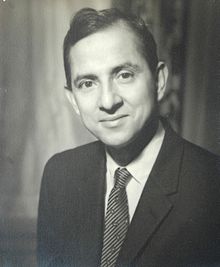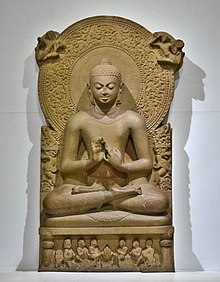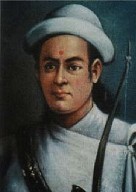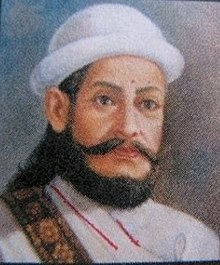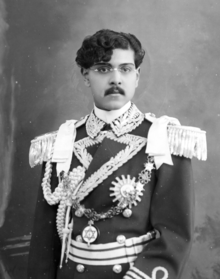Portal:Nepal/Featured biography
| This Wikipedia page has been superseded by Portal:Nepal and is retained primarily for historical reference. |
| Note: Article entries are now being transcluded directly on the main portal page. However, this page should be retained for historical reference. |
Featured biography 1
Portal:Nepal/Featured biography/1
Gyanendra Bir Bikram Shah Dev (Nepali: ज्ञानेन्द्र वीर विक्रम शाह देव; born 7 July 1947) is a former monarch and the last King of Nepal, reigning from 2001 to 2008. As a child, he was briefly king from 1950 to 1951, when his grandfather, Tribhuvan, took political exile in India with the rest of his family. His second reign began after the 2001 Nepalese royal massacre. Gyanendra Shah is the first person in the history of Nepal to be king twice and the last king of the Shah dynasty of Nepal.
Gyanendra's second reign was marked by constitutional turmoil. His brother King Birendra had established a constitutional monarchy in which he delegated policy to a representative government. The growing insurgency of the Nepalese Civil War during Gyanendra's reign interfered with the elections of representatives. After several delays in elections, Gyanendra suspended the constitution and assumed direct authority in February 2005, asserting that it would be a temporary measure to suppress the Maoist insurgency after civil governments had failed to do so. In the face of broad opposition, he restored the previous parliament in April 2006. He was deposed two years later by the first session of the Constituent Assembly, which declared the nation to be the Federal Democratic Republic of Nepal and abolished the 240-year-old Shah dynasty. (Full article...)
Featured biography 2
Portal:Nepal/Featured biography/2

Bidya Devi Bhandari (Nepali: विद्यादेवी भण्डारी, pronounced [bid̚djadebi bʱʌɳɖaɾi]; born 19 June 1961) is a Nepali former politician who served as the second president of Nepal from 2015 to 2023. She formerly served as the minister of defence and minister of environment and population.
She was the first woman to hold the office in the country. She served as the vice-chairperson of the Communist Party of Nepal (Unified Marxist–Leninist) and was the chair of the All Nepal Women's Association before being elected president. Bhandari previously served as the Minister of Defence, the first woman to hold the office, from 2009 to 2011. She also served as the Minister of Environment and Population in 1997, and has been an active campaigner for environmental awareness and women's rights in Nepal. In June 2017, she visited the headquarters of the International Union for Conservation of Nature in Gland, Switzerland and met with the director general Inger Andersen to discuss enhanced collaboration on nature conservation and sustainable development. In 2016, Forbes placed her as number 52 in their list of the world's 100 most powerful women. (Full article...)
Featured biography 3
Portal:Nepal/Featured biography/3
Khadga Prasad Sharma Oli (Nepali: खड्ग प्रसाद शर्मा ओली, pronounced [ˈkʰʌɽɡʌprʌsad̪ ˈoli]; born 22 February 1952) is a Nepali Communist politician, former Prime Minister of Nepal. He has served two terms as prime minister, from 11 October 2015 to 3 August 2016, and from 15 February 2018 to 13 July 2021 as the first prime minister to be appointed following the first general election under the new constitution.
KP Oli is noted for taking a more hardline stance with regard to the Indian government during and in the aftermath of the 2015 Nepal blockade. He strengthened relations with China as an alternative to Nepal's traditional close trade ties with India and updated the map of Nepal by constitutional amendment including territories disputed with India, for which he has received some domestic praise and a reputation as a nationalist. While in office, Oli was marred by controversy for frequent use of tongue-in-cheek remarks, hostility towards critics and the media, silence on corruption by colleagues and business aides, failing to deliver on economic growth, and for deviating from promised budgetary expenditures despite a historic majority in the 2017 legislative election (Full article...)
Featured biography 4
Portal:Nepal/Featured biography/4
Bhimsen Thapa (Nepali: भीमसेन थापाlisten (August 1775 – 29 July 1839)) was a Nepalese statesman who served as the Mukhtiyar (equivalent to prime minister) and de facto ruler of Nepal from 1806 to 1837. He is widely known as the longest-serving prime minister of Nepal and was inducted into the "National heroes of Nepal" by King Mahendra Bir Bikram Shah.
Born into an ordinary military family in the Gorkha Kingdom, Bhimsen first came close to the Crown Prince Rana Bahadur Shah at an early age in 1785. In 1798, he was recruited as a bodyguard for the King by his father. Thereafter, he rose to influence after helping the exiled ex-King Rana Bahadur Shah engineer his return to power in 1804. In gratitude, Rana Bahadur made Bhimsen a Kaji (equivalent to a minister) of the newly formed government. Rana Bahadur's assassination by his stepbrother Sher Bahadur Shah in 1806 led Bhimsen to initiate investigations into the context in which he ordered the death penalty for ninety-three people popularly known as the 1806 Bhandarkhal massacre, after which he claimed the title of Mukhtiyar (equivalent to prime minister) himself. The death of King Girvan Yuddha Bikram Shah in 1816 at the immature age of 17, with his heir, King Rajendra Bikram Shah being only 3 years old, along with the support from Queen Tripurasundari (the junior queen of Rana Bahadur Shah) allowed him to remain in power even after Nepal's defeat in the Anglo-Nepalese War. After the death of Queen Tripurasundari in 1832, the intrigues of the newly adult King Rajendra, the conspiracies and infightings with the British envoy Brian Houghton Hodgson, Senior Queen Samrajya Laxmi Devi and the rival courtiers (especially the Kala Pandes, who held Bhimsen Thapa responsible for the death of Damodar Pande in 1804) finally led to his imprisonment on false charges of the murder of an infant prince and ultimately his death by suicide in 1839. (Full article...)
Featured biography 5
Portal:Nepal/Featured biography/5
Anuradha Koirala (born Anuradha Gurung on 14 April 1949, in Okaldhunga district) is a Nepalese social activist and the founder of Maiti Nepal – a non-profit organization in Nepal, dedicated to helping victims of sex trafficking. She was appointed as 1st Governor of Bagmati Province from (17 January 2018 – 3 November 2019) by the Government of Nepal.
Anuradha Koirala was the first child of the colonel Pratap Singh Gurung and Laxmi Devi Gurung. She belonged to an educated family and had a great opportunity for education at St. Joseph Convent School. Before she started Maiti-Nepal, she spent 20 years as a teacher, teaching English in different schools in Kathmandu. ('Full article...)
Featured biography 6
Portal:Nepal/Featured biography/6
Aniko, Anige or Araniko (Nepali: अरनिको, Chinese: 阿尼哥; 1245–1306) was one of the key figures in the arts of Nepal and the Yuan dynasty of China, and the artistic exchanges in these areas. He was born in Kathmandu Valley during the reign of Abhaya Malla. He is known for building the White Stupa at the Miaoying Temple in Beijing. During the reign of Jayabhimadeva, he was sent on a project to build a golden stupa in Tibet, where he also initiated into monkhood. From Tibet he was sent further to northern China to work in the court of the emperor Kublai Khan, the founder of the Yuan dynasty, where he brought the trans-Himalayan artistic tradition to China. Araniko led a team of 80 artists to China proper and Tibet to make a number of pagoda-style buildings. In his later life, he renounced monkhood and started a family.
To some confusion in translation, his name is variously written as Arniko or Araniko in old texts. A mistake made by Baburam Acharya ascribed his Sanskrit name as Balabahu. However, later he contends that Aniko might possibly be the Chinese pronunciation for the Sanskrit name Aneka. It is also plausible that his name could mean AA Ni Ka, meaning "respectable brother from Nepal". (Full article...)
Featured biography 7
Portal:Nepal/Featured biography/7
Bishweshwar Prasad Koirala (Nepali: विश्वेश्वरप्रसाद कोइराला; 8 September 1914 – 21 July 1982), better known as B. P. Koirala (Nepali: बीपी कोइराला), was a Nepali revolutionary, political leader, and writer. He was the Prime Minister of Nepal from 1959 to 1960. He led the Nepali Congress, a social democratic political party. He was the grandfather of Bollywood actress Manisha Koirala and the older brother of former prime minister Girija Prasad Koirala and the younger brother of former prime minister Matrika Prasad Koirala.
Koirala was the first democratically elected and 22nd Prime Minister of Nepal. He held the office for 18 months before being deposed and imprisoned at the instruction of King Mahendra. The rest of his life was spent largely in prison or exile and in steadily deteriorating health.
Widely regarded as one of the greatest political personalities in Nepal, Koirala was a staunch supporter of democracy. He asserted that guarantees of individual liberty and civil and political rights alone were not sufficient in a poor country like Nepal, and that democratic socialism was the solution to Nepal's underdevelopment. (Full article...)
Featured biography 8
Portal:Nepal/Featured biography/8
Siddhartha Gautama, most commonly referred to as the Buddha ('the awakened'), was a wandering ascetic and religious teacher who lived in South Asia during the 6th or 5th century BCE and founded Buddhism. According to Buddhist legends, he was born in Lumbini, in what is now Nepal, to royal parents of the Shakya clan, but renounced his home life to live as a wandering ascetic. Buddhists believe that after leading a life of mendicancy, asceticism, and meditation, he attained nirvana at Bodh Gaya in what is now India. The Buddha then wandered through the lower Indo-Gangetic Plain, teaching and building a monastic order. Buddhist tradition holds he died in Kushinagar and reached parinirvana, final extinction.
According to Buddhist tradition, the Buddha taught a Middle Way between sensual indulgence and severe asceticism, leading to freedom from ignorance, craving, rebirth, and suffering. His core teachings are summarized in the Four Noble Truths and the Noble Eightfold Path, a training of the mind that includes ethical training and kindness toward others, and meditative practices such as sense restraint, mindfulness, dhyana (meditation proper) and the concept of dependent origination, emphasizing the impermanent and interconnected nature of all things.
About two centuries after his death, he came to be known by the title Buddha; his teachings were compiled by the Buddhist community in the Vinaya, his codes for monastic practice, and the Sutta Piṭaka, a compilation of teachings based on his discourses. These were passed down in Middle Indo-Aryan dialects through an oral tradition. Later generations composed additional texts, such as systematic treatises known as Abhidharma, biographies of the Buddha, collections of stories about his past lives known as Jataka tales, and additional discourses, i.e., the Mahayana sutras. (Full article...)
Featured biography 9
Portal:Nepal/Featured biography/9
Balbhadra Kunwar Chhetri (30 January 1789 – 13 March 1823) was a Gorkhali military commander and administrator in the Kingdom of Nepal. He is one of the National heroes of Nepal. He was highly praised for his military skill for the defence of Nalapani fort in the Anglo-Nepalese War (1814–1816). He was Captain in the Nepalese military and was tasked as commander to protect the forts of Dehradun. (Full article...)
Featured biography 10
Portal:Nepal/Featured biography/10
Bhrikuti Devi (Sanskrit: भृकुटी, known to Tibetans as Bal-mo-bza' Khri-btsun, Bhelsa Tritsun ("Besa" Nepal lit. 'Nepali consort'), or simply, Khri bTsun (lit. 'royal lady') was a princess of the Licchavi kingdom in Nepal. In c.622 Bhrikuti became the first wife and queen of the king of Tibet, Songtsen Gampo (c.605–650 CE). Bhrikuti was seen as an incarnation of Green Tara, and is credited for bringing Buddhism to Tibet, together with the Jowo Mikyo Dorje statue for which the Jokhang Temple in Lhasa was built. (Full article...)
Featured biography 11
Portal:Nepal/Featured biography/11
Maharajadhiraj Prithvi Narayan Shah (Nepali: श्री ५ बडामहाराजाधिराज पृथ्वीनारायण शाह देव), (7 January 1723 – 11 January 1775), was the last King of the Gorkha Kingdom and first King of the Kingdom of Nepal (also called the Kingdom of Gorkha). Prithvi Narayan Shah started the unification of Nepal.
Prithvi Narayan Shah is considered the Father of the Nation in Nepal. (Full article...)
Featured biography 12
Portal:Nepal/Featured biography/12
Amar Singh Thapa distinguished as Badakaji Amar Singh Thapa(Nepali: बडाकाजी अमर सिंह थापा), or Amar Singh Thapa The Elder, (also spelled Ambar Simha) also known by the honorific name Bada Kaji ("Senior Kaji") or Budha Kaji ("The Old Kaji"), was a Gorkhali military general, governor and warlord in the Kingdom of Nepal. He was the overall commander of the Nepal Army in the conquest of Western Provinces and authoritative ruler of Kumaon, Garhwal in the Kingdom of Nepal. He was referred by the King of Nepal to have been deployed as Mukhtiyar (equivalent to Prime Minister) of Western Provinces of Kumaon, Garhwal He is often hailed as Living Tiger of Nepal (Nepali: ज्यूँदो बाघ; jyūm̐do bāgha) and he was posthumously regarded as one of the national heroes of Nepal, who led the Anglo-Nepalese War for the Gorkhali Army. Amarsingh Chowk Pokhara and Shree Amarsingh Model Higher Secondary School are named after the name of Amar Singh Thapa. (Full article...)
Featured biography 13
Portal:Nepal/Featured biography/13
Tribhuvan Bir Bikram Shah (Nepali: त्रिभुवन वीर विक्रम शाह), (30 June 1906 – 13 March 1955) was the eighth King of Nepal. Born in Kathmandu, the capital city of Nepal, he ascended to the throne at the age of five, upon the death of his father, Prithvi Bir Bikram Shah, and was crowned on 20 February 1913 at the Nasal Chowk, Hanuman Dhoka Palace in Kathmandu, with his mother acting as regent. At the time of his crowning, the position of monarch was largely ceremonial, with the real governing power residing with the Rana family. (Full article...)






